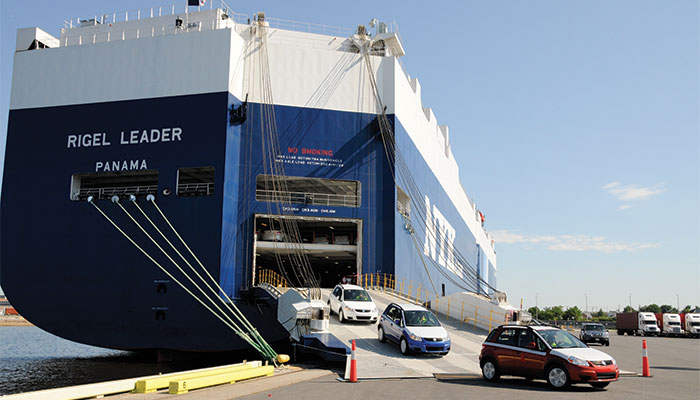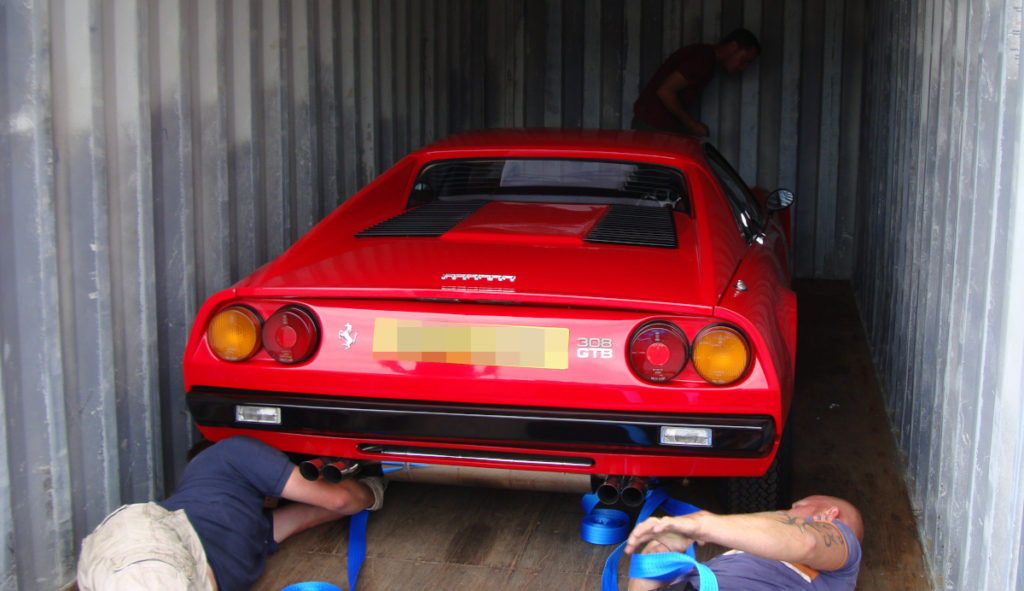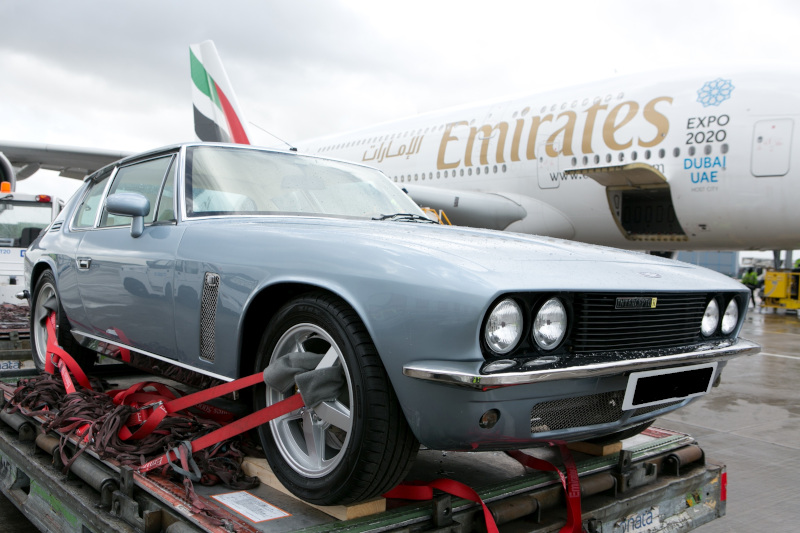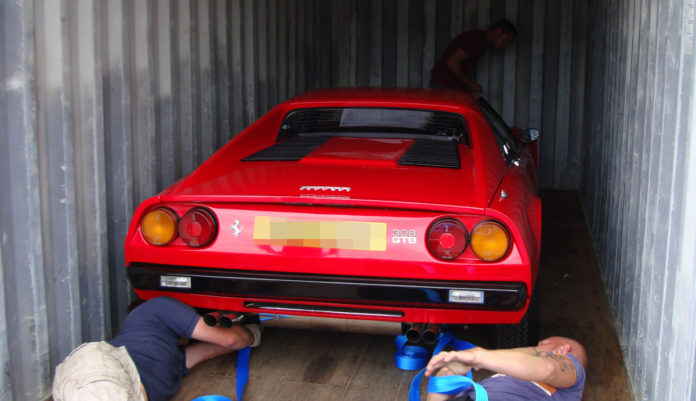If you’re shipping a car overseas, the first thing you’re going to have to decide on is the means by which you do so.
There are three options here – Ro-Ro shipping, container shipping and air freight – and AutoShippers offers all three services. So, here we’ll look at the respective pros and cons of each method to help you make an informed decision.
Ro-Ro Shipping
Ro-Ro stands for ‘roll-on, roll-off’, and refers to any type of shipping that involves land vehicles (usually cars, buses and trucks, although Ro-Ro ships that can carry railway rolling stock also exist) simply being driven onto a ship at one end of the journey, and driven off again at the other.


Ro-Ro car shipping really began to take off in the years immediately following the Second World War. Before that, cars had to be loaded onto vessels by crane, a process that was time-consuming and required a large crew of dock workers. The arrival of Ro-Ro ships made getting a car onto a ship a lot easier and cheaper, and led to a boom in the international motor vehicle trade.
Those same benefits, from the haulier’s point of view, still apply today – and as a result, Ro-Ro is generally the quickest, cheapest and easiest way to transport a vehicle from where the customer is sitting, too. You can simply drive your car to its port of departure and pick it up again at the other end. This is why Ro-Ro is the most popular means of shipping among AutoShippers customers.
However, Ro-Ro shipping isn’t always the best choice for all vehicles. While it’s perfectly safe – cars are lashed securely to the ship’s deck while in transit – it doesn’t offer quite the same level of protection from bumps and scrapes as containerised shipping. So if you’re shipping a very rare, expensive or high-end car, it may be better to go for the container option.
Likewise, Ro-Ro shipping does require your car to be capable of rolling on and off the ship in the first place! So if you’re shipping an older car that can’t, currently, actually be driven then you’ll need to use a container.
Finally, while Ro-Ro is generally quicker than containerised shipping – due to the more streamlined, less labour-intensive process involved – not all of the world’s ports are equipped to handle Ro-Ro vessels. In some instances, the nearest Ro-Ro port to your eventual destination may be a lot further away than the nearest container port, or possibly even in a neighbouring country. In such cases, the additional time and cost involved in collecting your car from its port of arrival might mean you’d be better opting for containerised shipping.
Container Shipping
We won’t beat about the bush here: it almost always (see below) costs more money to ship your car overseas inside a container than it does to take it overseas on a Ro-Ro vessel. But there are some good reasons why you might decide that the extra expense is worth it.


As we’ve already seen, if your car isn’t currently roadworthy then container car shipping may be your only option anyway. This is also the recommended route if you’re shipping a highly collectable or very expensive car: while accidents, scratches and thefts are rare in the case of Ro-Ro shipping, common sense alone will tell you that they’re rarer still if your car is safely locked away inside a large metal box!
These aren’t the only reasons you might opt for containerisation, though. As already discussed, it may be that there’s a container port a lot closer to your final destination than there is a Ro-Ro port, in which case the additional time and financial outlay involved in collecting your car from its port of arrival may outweigh the additional cost of container shipping – especially given that there are regular, weekly container lines servicing just about any port worldwide you care to name.
But perhaps the biggest deciding factor is what else you’re shipping. Ro-Ro is fine if all you’re moving is the car, but if you’re relocating overseas and have personal belongings to ship as well as your vehicle, then putting everything inside a container is probably the best bet. This is because once your car’s inside, the rest of your container can be packed out with whatever other personal effects you see fit, whereas – to speed up the customs clearance process, and to deter theft – cars that are being transported on a Ro-Ro vessel must be emptied of anything they didn’t leave the factory with.
Finally, it’s worth bearing in mind that containerised shipping might not be as expensive as you think it’s going to be! While the port fees and handling charges involved do exceed those for Ro-Ro shipping, you may be able to save money by shipping your car inside a shared container. In fact, there are specialised ‘R-Rak’ containers that have been specifically designed for just this purpose.
Using this method, up to four standard saloon cars can be fitted into a single 40-foot container – meaning that each owner pays just one-quarter of the port fees and handling charges, reducing the overall outlay considerably. You can also still pack out the inside of the car (though obviously not the whole container) with personal effects if you need to.
Air Freight Shipping
While the vast majority of cars we transport at AutoShippers travel to their destination on either a Ro-Ro or container ship, there is a third option available: air freight.


If Ro-Ro shipping is like catching the bus and containerised shipping is like getting a taxi, then air freight car shipping is like having your own private chauffeur. Using this method, your car can be collected from your front door in Glasgow, Leeds or Brighton one day, and arrive at your new home in Algiers, Miami or Montevideo just a day or two later – a speed with which ocean-going vessels simply cannot compete!
This method also offers the same kind of safety and security benefits as container shipping, because your vehicle will travel securely strapped inside a ULD (Unit Load Device) – the air transport equivalent of the standard shipping container.
The catch, unsurprisingly, is that air freight is expensive.
But if you do happen to the proud owner of a very valuable motor that needs to be somewhere in a hurry – if you’re taking a highly modified, custom-tuned Porsche to a track meet in the US, for instance – then air freight may be the way to go.
Any Questions?
Hopefully, reading this article will have given you a better understanding of the options available when taking a car overseas, enabling you to make an informed choice. But every case is different, so if you want advice on the best way to ship your vehicle, please don’t hesitate to get in touch – our team of specialist advisors will be happy to help you choose the shipping method that’s right for you.











